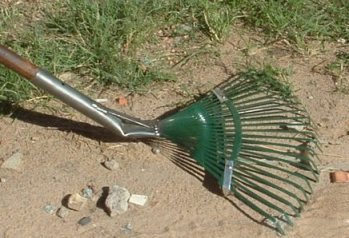Some years back I was sitting in Florida with Bill Patterson trying to release my hand from his steel desk after he pinned it there with some really powerful small magnets... These Southern boys have a crushing sense of humour.
Some months later, Richard Smith of Smith Engineering, Cumbria, sent me a simple switchable (on&off) magnet he had devised as a prototype hand tool. He asked me to get it tested and I complied, but the design was too complex and expensive and the magnetism too weak. I got the oldest deminer I've ever met to try it in Iraq - and he was polite when it fell apart.
A few months later I was watching deminers in Sri Lanka safely exposing mines with a light rake (leaf rake). And I freely admit that I was one of the cynics before I saw the complete REDs rake system, and before I had tried to set off a T72 with a light rake without success.
Later still, I was watching deminers in Cambodia sifting soil over a speaker-magnet in the search for elusive fragments that slowed down their advance to a snail's pace... Most of the spoil missed the magnet and they were reduced to rubbing the magnet on the ground to try to catch fragments. I have seen pieces of weak and broken magnet used optimistically by other groups, but it was CMAC who made the best use of it.
Combining the ideas of Bill Patterson, Luke Atkinson, CMAC, and no doubt others I have brain-picked over the years, I put together some simple magnetic attachments for existing tools.
It was not long before I could watch deminers using magnetic light rakes on heavily fragmented areas and finding those within 2cm of the surface with the rake, so speeding up metal-detector search dramatically. The rakes also exposed the tops of shallow mines. In an identical area, deminers using clip-on trowel magnets had the same de-fragmentation success, and were able to sift soil as they excavated detector signals efficiently because the magnet extended along one edge of the tool (both sides). First they passed the back of the tool above the ground surface and the powerful little suckers dragged frag out so that it clacked on the demining trowels (these trowels were blast-resistant stainless-steel and unmagnetised). If that didn't work, they scraped the ground surface flat with a lateral movement (no downward pressure) and rolled the spoil over the magnet clip. When both failed, they used a prod to break the ground surface and tipped the spoil over the magnet as they moved it aside. All ferrous fragments were found with the magnet.
These small neodymium magnets are far more powerful than I expected and very light. They are an inexpensive addition that can make search and clearance faster almost everywhere, and very much faster in heavily fragmented areas. The light rake version shown below has a strip of magnets that is moved from rake to rake as the rakes wear out.

My design of magnetic tool-clip fits any sharp-edged tool (recommended for use on stainless steel tools only), and changes from side to side for the right and left handed.
Incidentally, I once collected the scrap from three minefields and sorted the ferrous from non-ferrous. The ratio was more than 50:1, ferrous/non-ferrous. True, that is only one province, in one country, at one time, but it's an indication that, in my experience, seems to be pretty representative of many mined areas.
So, I took my magnet designs to two commercial demining suppliers and gave them away. They both made them but one has since gone out of business. I then used a little scrap polycarbonate to make the long magnet wand shown below. I did this because the magnets are brittle and will shatter if there is a blast, so I wanted them to be as far as possible from my hand.

Magnet tools are easy enough for any handy person to make themselves.
Whenever using a light rake, it should be tested whether the sprung-tines will initiate the anticipated types of AP mine. The mines should be in good condition because no excavation system is safe when the mines are in a poor condition, and because the light rake allows the user to be standing a metre and a half back in visor and armour, so is inherently safer than other excavation procedures.
The Atkinson/NPA REDS system uses rakes for excavation and detection - without metal detectors - and is both effective and impressive. It gives a higher confidence of full clearance to depth than any other excavation system I have seen (which is all common manual methods, plus a few uncommon ones). See also this Rake Case Study and the detailed use of rakes described in Chapter 6 of the Global SOPs.
The magnetic light rake is probably the most significant real tool advance since blast-resistance became an achievable issue, and the only tool advance there has ever been with such a potential for safely increasing speed of search and clearance with metal-detectors. At the same time it can safely remove cut vegetation, leaf mould, and loose topsoil and expose the tops of shallow mines. But the fact is, I know of no demining group that is currently using it.
Return to COMMENT.